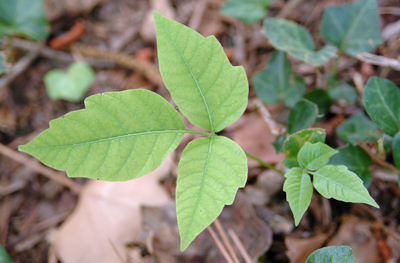As summer comes to its apex you may find yourself longing to move your activities outdoors and commune with nature. However, as you are reveling in the warm weather while hiking, camping, biking, gardening, etc. remember that there are native plants of a less friendly nature hiding in plain sight. I’m sure you have all heard the tried and true mantra “Leaves/leaflets of three, let it be”, we suggest you hum that to yourself as you head outdoors in order to save yourself from the consequences of an accidental poison ivy encounter.
While I am not a native of Florida, I grew up in the Deep South and I have had many dealings with our aforementioned foe. Poison ivy (Toxicodendron radicans) is a native to North America which contains an oil known as urushiol. This oil can cause a severe skin rash (dermatitis) when any part of the plant is contacted. The reaction and rash, in susceptible humans, usually starts with itchiness and swelling, followed by the reddish inflammation of tiny pimples or formation of blisters at the areas of contact. The rash can begin as early as an hour after contact or up to five days after contact. All parts of poison ivy, including the hairy-looking aerial roots, contain urushiol at all times of the year, even when bare of leaves and fruit in winter. An allergic reaction can occur by touching the plant directly or indirectly contacting it through animals, tools, clothing, shoes and other items. Also, be aware when preparing your campfires and bonfires that the smoke from burning poison ivy contains oil particles that can be inhaled and cause lung irritation.
Now that you know the consequences of coming in to contact with poison ivy, let’s talk about where you can find it and how it can be identified. Poison ivy can grow in shady or sunny locations throughout Florida. It’s habit can be a woody shrub up to 6 feet tall or a vine up to 150 feet tall that climbs high on trees, walls and fences or trails along the ground. Leaves emerge with a shiny reddish tinge in the spring and turn a dull green as they age, eventually turning shades of red or purple in the fall before dropping.
Poison ivy has little or no effect on animals, but, as we discussed, they may carry the irritating substance on their hair and thereby transmit it to us more susceptible humans. Not only are the berries attractive to birds, but the leaves and fruit are also an important food source for deer.
Poison ivy is often confused with another native, the Virginia creeper (Parthenocissus quinquefolia). However, this trailing or climbing vine can be distinguished from poison ivy rather easily by its five divided leaflets. Also, Virginia creeper has blue-black berries and tendrils that end in tiny sticky pads that attach to trees and other surfaces.
So, what methods of treatment are available to those who suffer the wrath of poison ivy? If you suspect that you have come into contact with poison ivy always wash your skin with strong soap and cold water immediately! If you scrub with hot water you will open up your pores and let the oil into your skin, causing further irritation. Remove and wash all clothes, including shoes and socks in a strong detergent and warm or hot water. Keep your hands away from eyes, mouth and face. Don’t scratch the rash! To soothe the itch apply calamine lotion, zinc oxide or other doctor recommended products. Always call and visit your doctor if these measures don’t work, you know you are highly allergic or the rash persists.
So, how can you stop poison ivy at the source and avoid these painful symptoms? The first approach would be to eradicate an area by hand removal. Anyone who is extremely sensitive to the oil should ask for help when removing these plants. Always wear proper clothing that covers all areas that could potentially come in to contact with the plant. Also, lotions and creams containing the active ingredient bentoquatam can be used before the weed whacking begins. A suggested technique for removal using chemicals is to cut out a section of actively growing vine and promptly applying a legal herbicide to the bottom half of the cut stem to control re-sprouting. Choose a herbicide only after reading the pesticide label. Some products are labeled for specific sites, and pesticide registrations change over time. Please check with your UF/IFAS Extension service for current recommendations. Hopefully, this article will help you take preventative and proper measures against poison ivy and give you a more care free and informed attitude when partaking in summer activities!
- Reference Books for Gardeners and Landscapers Alike - August 3, 2015
- The Danger Within… What’s Hiding in Our Woods - June 15, 2015
- What To Do with All This Rain? Plant a Rain Garden! - April 14, 2015

